Lifting Wavelet Transform De-noising for Model Optimization of Vis-NIR Spectroscopy to Predict Wood Tracheid Length in Trees
Abstract
:1. Introduction
2. Materials and Methods
2.1. Sample Preparation
2.2. Vis-NIR Spectroscopy
2.3. Tracheid Length Measurement and Calibrations
2.4. Vis-NIR Data Processing
2.4.1. Lifting Wavelet Transform Analysis
2.4.2. Local Correlation Maximization Algorithm
- Correlation analysis: the correlation coefficient (r) between Vis-NIR spectra under different decomposition levels and tracheid length were obtained.
- Judgment analysis: for the wavelength range of 350–2397 nm, each wavelength corresponds to multiple correlation coefficients, and the decomposition layer with the largest r in all decomposition layers was selected as the decomposition layer for this wavelength.
- Construction of spectra: the spectra were constructed by the absorbance of the decomposition level with the largest r.
2.4.3. Comparison with Basic De-Noising Methods
2.5. Overview of Vis-NIR Spectra De-Noising Processing
3. Results and Analysis
3.1. Statistical Characteristics of Wood Tracheid Length
3.2. Radial Development of Wood Tracheid Length in Annual Rings
3.3. Selection of Optimal LWT De-Noising Parameters
3.4. Comparison with Basic De-Noising Methods
3.5. Establishment of Vis-NIR Models for Wood Tracheid Length
4. Discussion
5. Conclusions
Author Contributions
Funding
Conflicts of Interest
References
- Miloš, B.; Bensa, A. Estimation of calcium carbonate in anthropogenic soils on flysch deposits from Dalmatia (Croatia) using Vis-NIR spectroscopy. Agric. For. 2017, 63, 121–130. [Google Scholar] [CrossRef]
- Verbeek, F.P.R.; Troyan, S.L.; Mieog, J.S.; Liefers, G.J.; Moffitt, L.A.; Rosenberg, M.; Hirshfield-Bartek, J.; Gioux, S.; Velde, C.J.H.; Vahrmeijer, A.L.; et al. Near-infrared fluorescence sentinel lymph node mapping in breast cancer: A multicenter experience. Breast Cancer Res. Treat. 2014, 143, 333–342. [Google Scholar] [CrossRef] [PubMed]
- Duconseille, A.; Andueza, D.; Picard, F.; Santé-Lhoutellier, V.; Astruc, T. Molecular changes in gelatin aging observed by NIR and fluorescence spectroscopy. Food Hydrocolloids 2016, 61, 496–503. [Google Scholar] [CrossRef]
- Zanuncio, A.J.V.; Hein, P.R.G.; Carvalho, A.G.; Rocha, M.F.V.; Carneiro, A.C.O. Determination of heat-treated eucalyptus and pinus wood properties using NIR spectroscopy. J. Trop. For. Sci. 2018, 30, 117–125. [Google Scholar] [CrossRef]
- Via, B.K.; Zhou, C.F.; Acquah, G.; Jiang, W.; Eckhardt, L. Near infrared spectroscopy calibration for wood chemistry: Which chemometric technique is best for prediction and interpretation. Sensors Basel 2014, 14, 13532–13547. [Google Scholar] [CrossRef] [PubMed]
- Schimleck, L.R.; Matos, J.L.M.; Trianoski, R.; Prata, J.G. Comparison of methods for estimating mechanical properties of wood by NIR spectroscopy. J. Spectrosc. 2018, 2018, 1–10. [Google Scholar] [CrossRef]
- Hein, P.R.G.; Pakkanen, H.K.; Dos Santos, A.A. Challenges in the use of near infrared spectroscopy for improving wood quality: A review. For. Syst. 2017, 26, eR03. [Google Scholar] [CrossRef]
- Wu, Z.S.; Ouyang, G.Q.; Shi, X.Y.; Ma, Q.; Wan, G.; Qiao, Y.J. Absorption and quantitative characteristics of C-H bond and O-H bond of NIR. Opt. Spectrosc. 2014, 117, 703–709. [Google Scholar] [CrossRef]
- Tenenhaus, M.; Esposito Vinzi, V.; Chatelinc, Y.M.; Lauro, C. PLS path modeling. Comput. Stat. Data Anal. 2005, 48, 159–205. [Google Scholar] [CrossRef]
- Balabin, R.M.; Lomakina, E.I.; Safieva, R.Z. Neural network (ANN) approach to biodiesel analysis: Analysis of biodiesel density, kinematic viscosity, methanol and water contents using near infrared (NIR) spectroscopy. Fuel 2011, 90, 2007–2015. [Google Scholar] [CrossRef]
- Cheng, Q.; Zhou, C.F.; Jiang, W.; Zhao, X.P.; Via, B.; Wan, H. Mechanical and physical properties of OSB exposed to high temperature and relative humidity and coupled with NIR modeling. For. Prod. J. 2018, 68, 78–85. [Google Scholar] [CrossRef]
- Kurata, Y. Nondestructive classification analysis of wood soaked in seawater by using near-infrared spectroscopy. For. Prod. J. 2017, 67, 63–68. [Google Scholar] [CrossRef]
- Rossel, R.A.; Webster, R. Predicting soil properties from the Australian soil visible-near infrared spectroscopic database. Eur. J. Soil Sci. 2012, 63, 848–860. [Google Scholar] [CrossRef]
- Li, Y.; Li, Y.X.; Li, W.B.; Jiang, L.C. Model optimization of wood property and quality tracing based on wavelet transform and NIR spectroscopy. Spectrosc. Spect. Anal. 2018, 38, 1384–1392. [Google Scholar] [CrossRef]
- Liu, J.L.; Sun, B.L.; Yang, Z. Estimation of the physical and mechanical properties of Neosinocalamus Affinins using near infrared spectroscopy. Spectrosc. Spect. Anal. 2011, 31, 647–651. [Google Scholar] [CrossRef]
- Li, Y.; Li, Y.X.; Xu, H.K.; Jiang, L.C. Model calibrating for NIRS-based oak wood air-dry density prediction with de-noising pretreatment. J. Nanjing For. Univ. 2016, 40, 148–156. [Google Scholar] [CrossRef]
- Yang, X.F.; Zhang, W.; Yang, Y.X. Denoising technology of radar life signal based on lifting wavelet transform. Acta Opt. Sin. 2014, 34, 300–305. [Google Scholar] [CrossRef]
- Via, B.K.; So, C.L.; Groom, L.H.; Shupe, T.F.; Stine, M.; Wikaira, J. Within tree variation of lignin, extractives, and microfibril angle coupled with the theoretical and near infrared modeling of microfibril angle. IAWA J. 2007, 28, 189–209. [Google Scholar] [CrossRef]
- Sadegh, A.N.; Kiaei, M. Formation of juvenile/mature wood in Pinus eldarica medw and related wood properties. World Appl. Sci. J. 2011, 12, 460–464. [Google Scholar]
- Zhang, X.C.; Wu, J.Z.; Xu, Y. Near Infrared Spectroscopy Technique and Applications in Modern Agriculture; Publishing House of Electronics Industry: Beijing, China, 2012; pp. 48–49. [Google Scholar]
- Wang, Y.T.; Yang, Z.; Hou, P.G.; Cheng, P.F.; Cao, L.F. Research on spectroscopy spectrum de-noising of mineral oil based on lifting scheme wavelet transform. Spectrosc. Spect. Anal. 2016, 36, 2144–2147. [Google Scholar] [CrossRef]
- Zhou, F.B.; Li, C.G.; Zhu, H.Q. Research on threshold improved denoising algorithm based on lifting wavelet transform in UV-Vis spectrum. Spectrosc. Spect. Anal. 2018, 38, 506–510. [Google Scholar] [CrossRef]
- Yan, Y.L.; Chen, B.; Zhu, D.Z. Near Infrared Spectroscopy-Principle/Technology and Application; China Light Industry Press: Beijing, China, 2013; pp. 172–174. [Google Scholar]
- Zhang, R.; Li, Z.F.; Pan, J.J. Coupling discrete wavelet packet transformation and local correlation maximization improving prediction accuracy of soil organic carbon based on hyperspectral reflectance. Trans. Chin. Soc. Agric. Eng. 2017, 33, 175–181. [Google Scholar] [CrossRef]
- Boggess, A.; Narcowich, F.J. A First Course in Wavelets with Fourier Analysis, 2nd ed.; Publishing House of Electronics Industry: Beijing, China, 2010; pp. 211–217. [Google Scholar]
- Srivastava, M.; Lindsay Anderson, C.; Freed, J.H. A new wavelet denoising method for selecting decomposition levels and noise thresholds. IEEE Access 2016, 4, 3862–3877. [Google Scholar] [CrossRef] [PubMed]
- Cai, L.H.; Ding, J.L. Inversion of soil moisture content based on hyperspectral multi-scale decomposition. Laser Optoelectron. Progress 2018, 55, 013001. [Google Scholar] [CrossRef]
- Boruszewski, P.; Jankowska, A.; Kurowska, A. Comparison of the structure of juvenile and mature wood of Larix decidua mill from fast-growing plantations in Poland. Bioresources 2017, 12, 1813–1825. [Google Scholar] [CrossRef]
- Schimleck, L.R.; Jones, P.D.; Peter, G.F.; Daniels, R.F.; ClarkllI, A. Nondestructive estimation of tracheid length from sections of radial wood strips by near infrared spectroscopy. Holzforschung 2004, 58, 375–381. [Google Scholar] [CrossRef]
- Mäkinen, H.; Jaakkola, T.; Piispanen, R.; Saranpää, P. Predicting wood and tracheid properties of Norway spruce. For. Ecol. Manag. 2007, 24, 1175–1188. [Google Scholar] [CrossRef]
- Via, B.K.; Shupe, T.F.; Stine, M.; So, C.L.; Groom, L.H. Tracheid length prediction in Pinus palustris by means of near infrared spectroscopy: The influence of age. Eur. J. Wood Prod. 2005, 63, 231–236. [Google Scholar] [CrossRef]
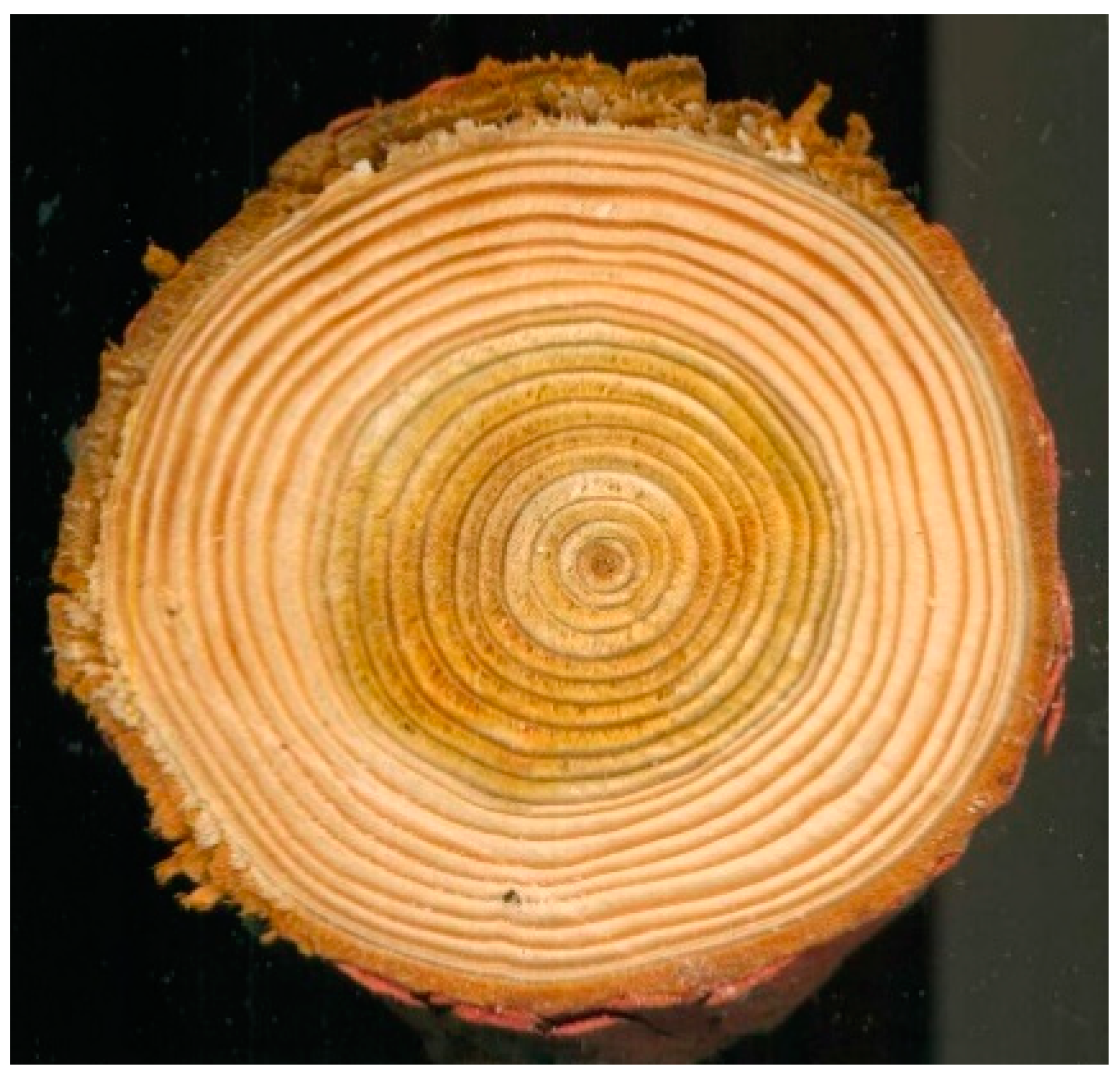
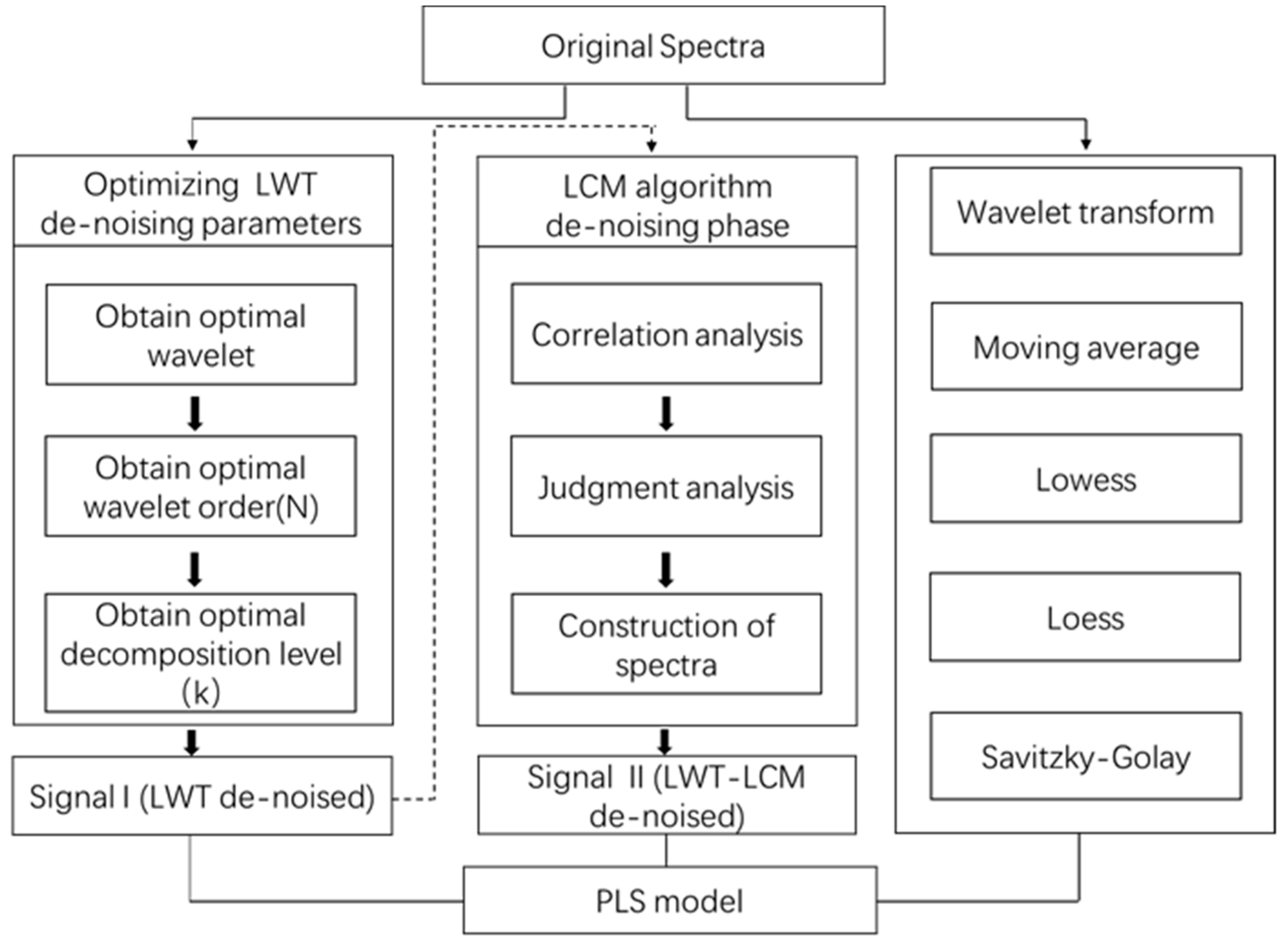

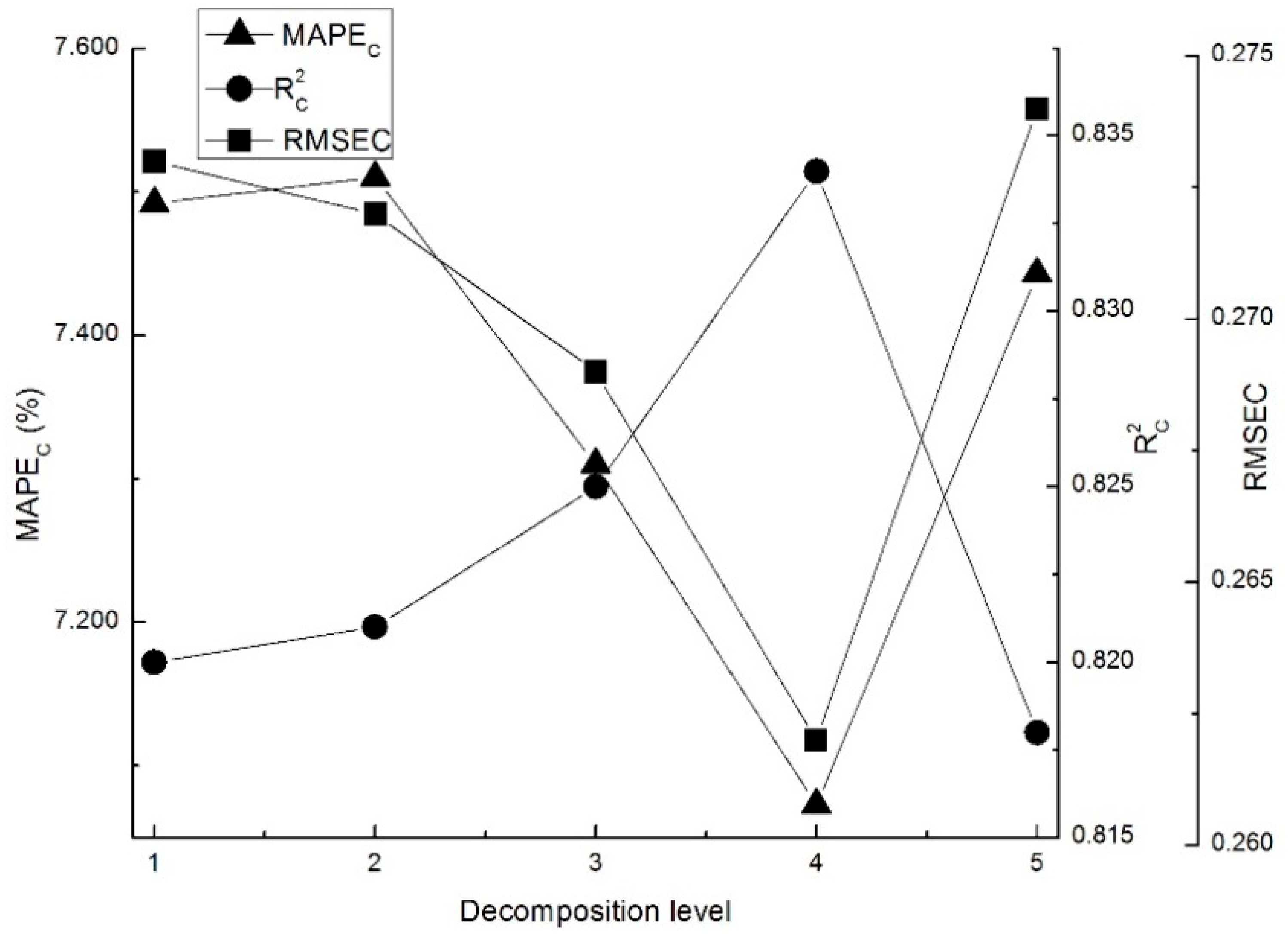
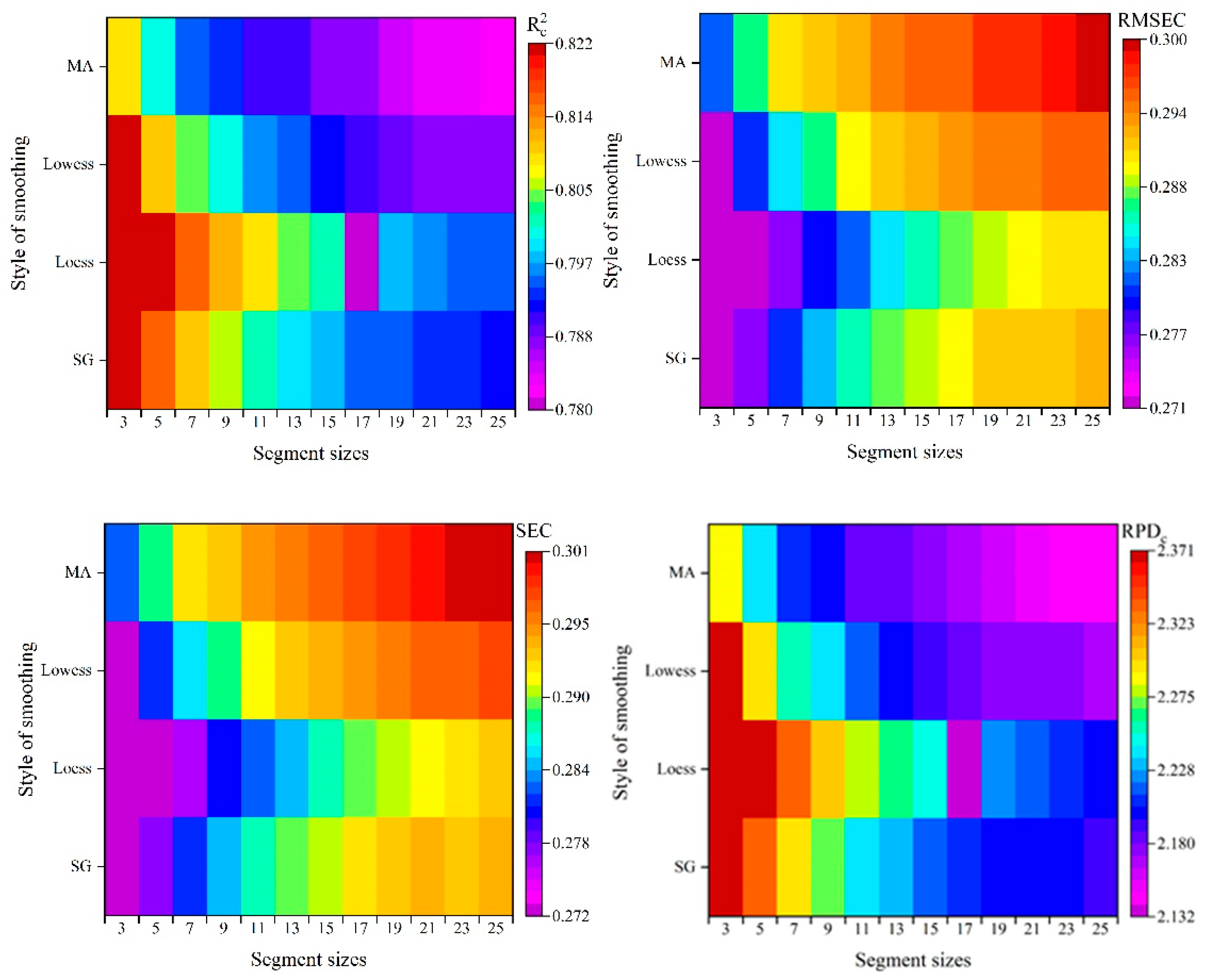

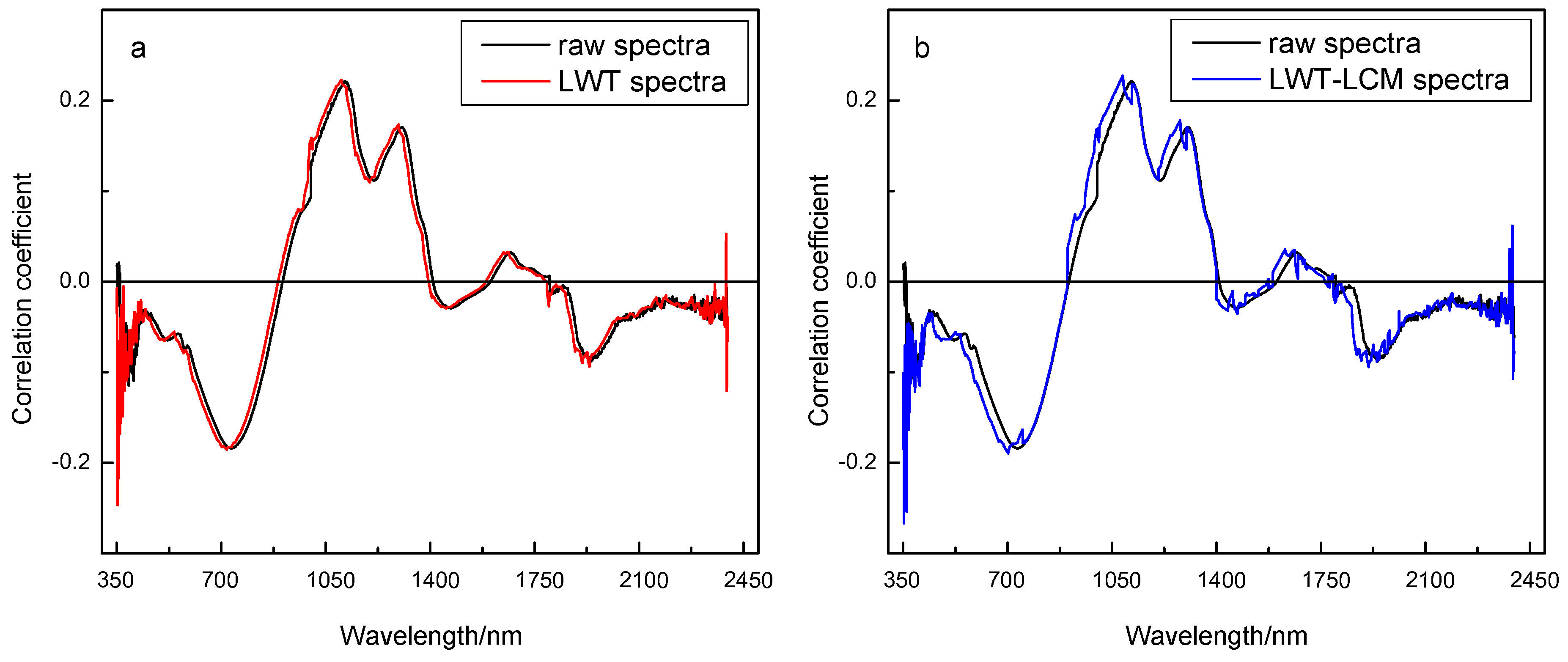
| Sample Set | No. of Samples | Max (mm) | Min (mm) | Avg. (mm) | SD (mm) | Skewness | Kurtosis |
|---|---|---|---|---|---|---|---|
| Calibration Set | 117 | 4.169 | 1.626 | 3.234 | 0.645 | −0.715 | −0.539 |
| Prediction Set | 47 | 4.618 | 1.951 | 3.534 | 0.678 | −0.614 | −0.285 |
| Total | 164 | 4.618 | 1.626 | 3.320 | 0.667 | −0.603 | −0.421 |
| Wavelet | PCs | RMSEC | MAPEc (%) | |
|---|---|---|---|---|
| sym5 | 7 | 0.783 | 0.300 | 8.185 |
| bior5.5 | 5 | 0.395 | 0.500 | 13.460 |
| rbio5.5 | 7 | 0.503 | 0.453 | 12.407 |
| db5 | 7 | 0.811 | 0.279 | 7.639 |
| dbN | RMSEC | MAPEc (%) | |
|---|---|---|---|
| db1 | 0.807 | 0.282 | 7.782 |
| db2 | 0.818 | 0.274 | 7.443 |
| db3 | 0.763 | 0.313 | 8.738 |
| db4 | 0.809 | 0.281 | 7.839 |
| db5 | 0.811 | 0.279 | 7.639 |
| db6 | 0.600 | 0.406 | 10.971 |
| db7 | 0.789 | 0.295 | 8.304 |
| db8 | 0.444 | 0.479 | 13.384 |
| Model | PCs | Calibration Set | Validation Set | ||||||
|---|---|---|---|---|---|---|---|---|---|
| RMSEC | SEC | RMSEP | SEP | ||||||
| Raw | 7 | 0.822 | 0.271 | 0.272 | 2.370 | 0.714 | 0.347 | 0.349 | 1.870 |
| LWT | 7 | 0.834 | 0.262 | 0.263 | 2.454 | 0.722 | 0.344 | 0.345 | 1.897 |
| LWT-LCM | 7 | 0.816 | 0.276 | 0.277 | 2.331 | 0.683 | 0.365 | 0.367 | 1.776 |
| WT | 7 | 0.816 | 0.275 | 0.277 | 2.331 | 0.717 | 0.347 | 0.346 | 1.880 |
© 2018 by the authors. Licensee MDPI, Basel, Switzerland. This article is an open access article distributed under the terms and conditions of the Creative Commons Attribution (CC BY) license (http://creativecommons.org/licenses/by/4.0/).
Share and Cite
Li, Y.; Via, B.K.; Cheng, Q.; Li, Y. Lifting Wavelet Transform De-noising for Model Optimization of Vis-NIR Spectroscopy to Predict Wood Tracheid Length in Trees. Sensors 2018, 18, 4306. https://doi.org/10.3390/s18124306
Li Y, Via BK, Cheng Q, Li Y. Lifting Wavelet Transform De-noising for Model Optimization of Vis-NIR Spectroscopy to Predict Wood Tracheid Length in Trees. Sensors. 2018; 18(12):4306. https://doi.org/10.3390/s18124306
Chicago/Turabian StyleLi, Ying, Brian K. Via, Qingzheng Cheng, and Yaoxiang Li. 2018. "Lifting Wavelet Transform De-noising for Model Optimization of Vis-NIR Spectroscopy to Predict Wood Tracheid Length in Trees" Sensors 18, no. 12: 4306. https://doi.org/10.3390/s18124306
APA StyleLi, Y., Via, B. K., Cheng, Q., & Li, Y. (2018). Lifting Wavelet Transform De-noising for Model Optimization of Vis-NIR Spectroscopy to Predict Wood Tracheid Length in Trees. Sensors, 18(12), 4306. https://doi.org/10.3390/s18124306




